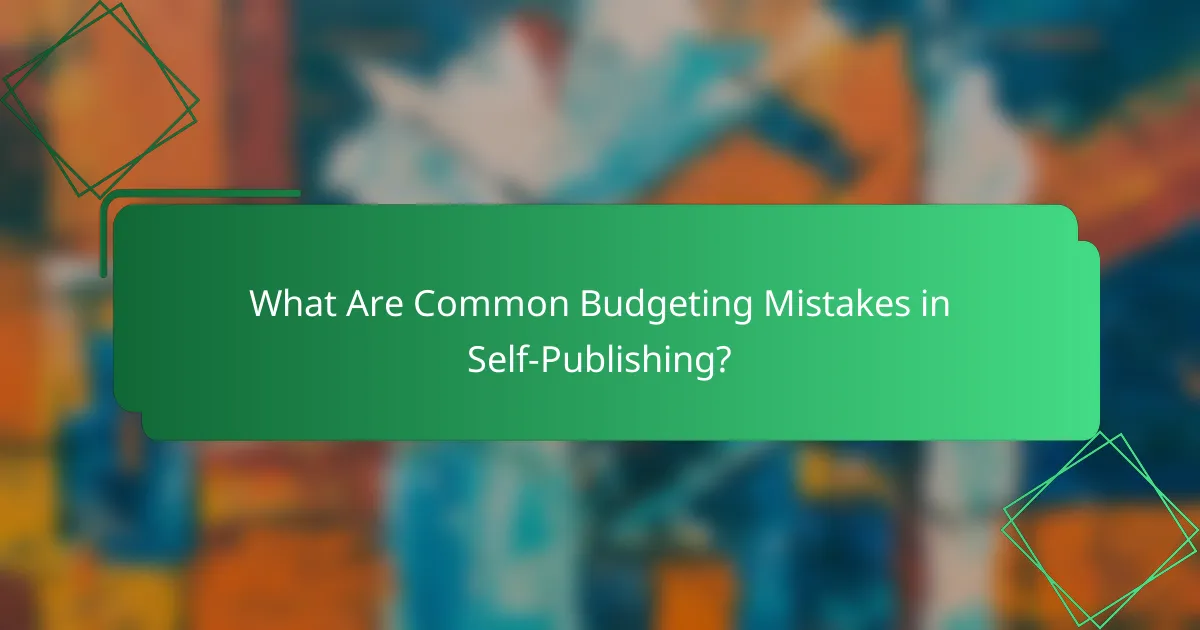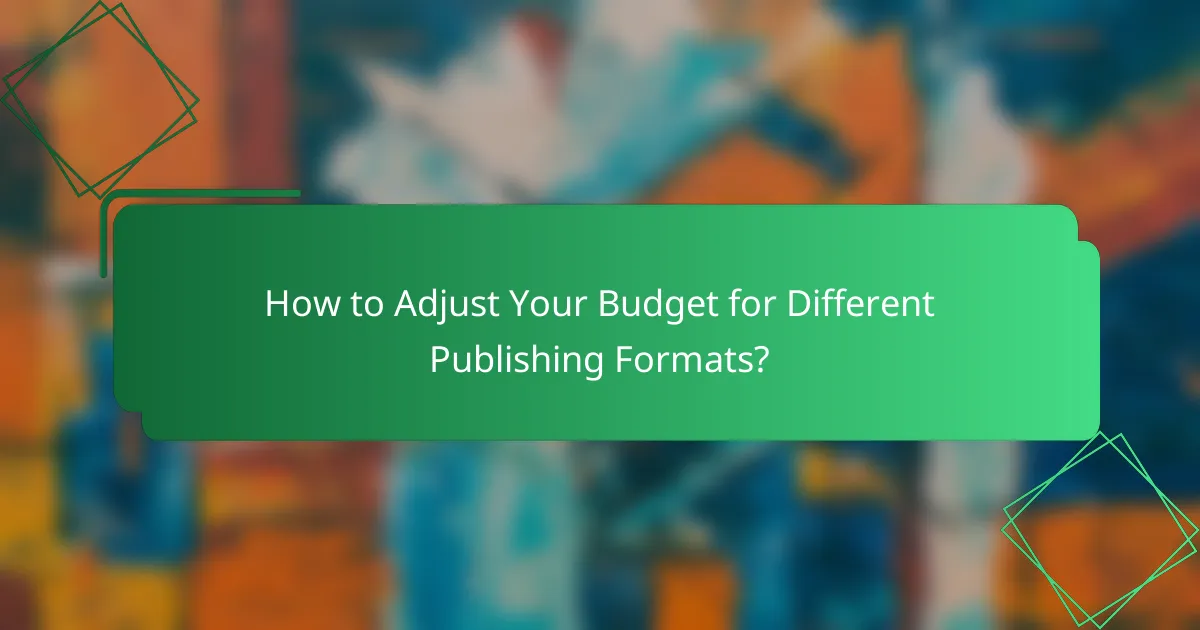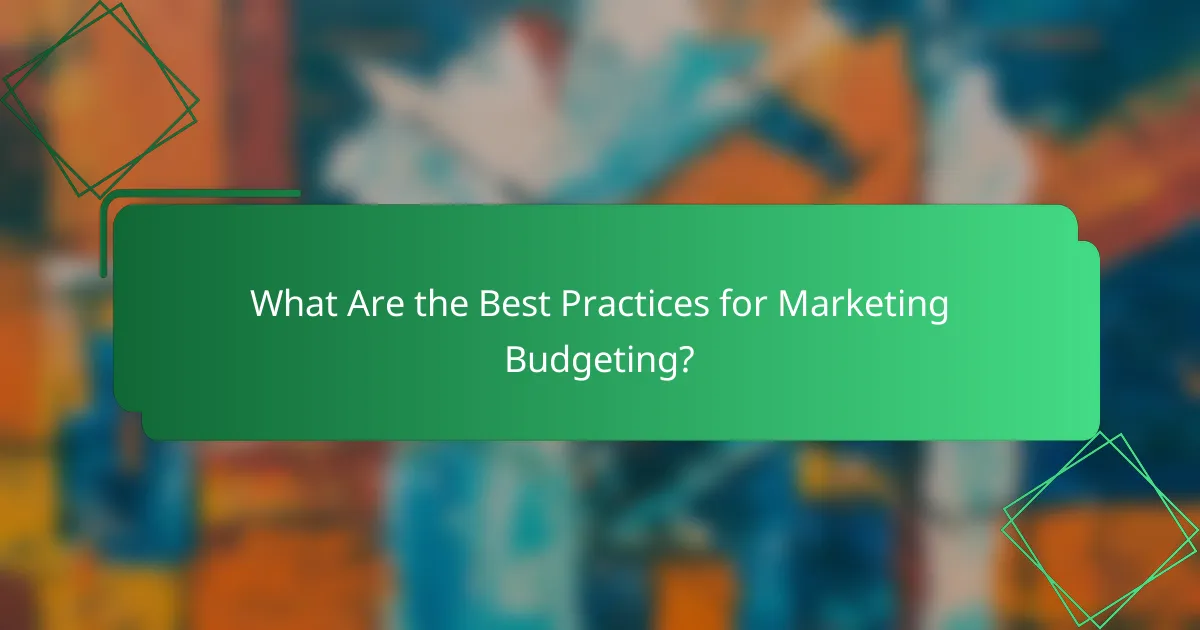Self-publishing can be an exciting journey, but it requires careful financial planning to ensure success. By creating a comprehensive budget that identifies potential costs and estimates income, new authors can allocate their resources wisely. Utilizing essential budgeting tools can help manage expenses and track income, while avoiding common pitfalls will keep the project on track and within budget.

How to Create a Self-Publishing Budget?
Creating a self-publishing budget involves identifying all potential costs and estimating expected income. This process helps new authors allocate their resources effectively to ensure a successful book launch.
Identify key expenses
Key expenses in self-publishing include costs for editing, design, printing, and distribution. Authors should list all potential expenses to get a clear picture of their financial needs.
Consider breaking down expenses into fixed costs, such as ISBNs and cover design, and variable costs, like printing based on quantity. This will help in understanding the total investment required.
Estimate potential income
Estimating potential income involves projecting sales based on market research and pricing strategies. Authors should consider factors like genre popularity and target audience to set realistic sales goals.
Utilizing platforms like Amazon or local bookstores can provide insights into pricing and sales averages. Calculating potential income can help authors gauge whether their budget aligns with expected returns.
Allocate funds for marketing
Marketing is crucial for a successful self-publishing venture, and authors should allocate a portion of their budget specifically for this purpose. This can include social media advertising, book launch events, and promotional materials.
Setting aside around 10-20% of the total budget for marketing efforts is a common practice. Effective marketing can significantly enhance visibility and drive sales, making this investment worthwhile.
Consider editing and design costs
Editing and design are critical components of self-publishing that can greatly impact the quality of the final product. Authors should budget for professional editing services, which can range from a few hundred to several thousand dollars depending on the manuscript’s length and complexity.
Cover design is equally important, as it influences first impressions. Investing in a professional designer can cost between $200 and $1,500, depending on the designer’s experience and the complexity of the design.
Plan for distribution expenses
Distribution expenses include costs associated with getting the book into readers’ hands, whether through print or digital formats. Authors should consider fees for platforms like Amazon Kindle Direct Publishing or IngramSpark, which can charge setup fees and take a percentage of sales.
Additionally, if authors plan to sell physical copies at events or through local bookstores, they should account for shipping and handling costs. Budgeting for these expenses ensures that authors are prepared for all aspects of distribution.

What Are the Essential Budgeting Tools for Authors?
Essential budgeting tools for authors help manage finances effectively throughout the self-publishing process. These tools can track expenses, manage income, and provide insights into overall financial health, ensuring authors stay within their budget.
Excel for budgeting
Excel is a versatile tool for authors looking to create a detailed budget. It allows for customizable spreadsheets where you can input costs related to writing, editing, cover design, and marketing. You can easily track your spending against your budgeted amounts, making adjustments as necessary.
To get started, create categories for different expenses and use formulas to calculate totals. Consider using templates available online to save time. Regularly updating your spreadsheet can help you stay on top of your finances and avoid overspending.
QuickBooks for financial tracking
QuickBooks is a robust accounting software that offers comprehensive financial tracking for authors. It helps manage income and expenses, generate invoices, and prepare for tax season by keeping all financial records organized. This tool is particularly useful for authors who have multiple income streams or complex financial situations.
When using QuickBooks, set up different accounts for various income sources, such as book sales, royalties, and speaking engagements. This will give you a clearer picture of your financial performance. Additionally, consider integrating bank accounts to automate transaction tracking, which can save time and reduce errors.
Mint for expense management
Mint is a user-friendly app designed for personal finance management, making it ideal for authors who want to keep track of their expenses effortlessly. By linking your bank accounts and credit cards, Mint automatically categorizes your spending, providing insights into where your money goes.
To maximize Mint’s potential, set budget limits for different categories related to your writing projects. Regularly review your spending reports to identify areas where you can cut costs. This proactive approach can help you maintain a healthy budget while pursuing your writing goals.

What Are Common Budgeting Mistakes in Self-Publishing?
Common budgeting mistakes in self-publishing can lead to overspending or inadequate funding, jeopardizing the success of a book. New authors often overlook essential costs, fail to allocate enough for marketing, and neglect hidden expenses that can arise throughout the publishing process.
Underestimating costs
Many new authors underestimate the costs associated with self-publishing, which can include editing, cover design, formatting, and distribution fees. A typical budget might range from a few hundred to several thousand dollars, depending on the quality of services chosen. It’s crucial to research and obtain quotes to create a realistic budget that reflects potential expenses.
To avoid underestimating costs, consider breaking down each component of the publishing process and assigning a budget to each. For example, professional editing can range from $0.01 to $0.03 per word, while cover design might cost anywhere from $100 to $1,000 or more, depending on the designer’s expertise.
Neglecting marketing budget
Neglecting to allocate a sufficient marketing budget is a common mistake that can severely limit a book’s visibility and sales. Authors should plan to spend at least 20-30% of their total budget on marketing efforts, which may include social media ads, book launch events, and promotional materials.
Effective marketing strategies can vary widely in cost. For instance, a targeted Facebook ad campaign might start at $5 per day, while hiring a publicist could cost several hundred dollars per month. Authors should prioritize marketing early in the budgeting process to ensure they have the resources to promote their work effectively.
Ignoring hidden expenses
Hidden expenses can significantly impact a self-publishing budget if not accounted for. These may include costs for ISBNs, copyright registration, and ongoing expenses like website hosting or email marketing services. Authors should be aware that these costs can add up quickly and should be factored into the overall budget.
To manage hidden expenses, create a checklist of potential costs associated with self-publishing. For example, an ISBN can cost around $125 for a single number, while copyright registration may be around $55. By anticipating these expenses, authors can avoid financial surprises and ensure they remain within budget throughout the publishing journey.

How to Adjust Your Budget for Different Publishing Formats?
Adjusting your budget for different publishing formats involves understanding the unique costs associated with each format. Whether you choose print, eBook, or hybrid publishing, each option has its own financial implications that can significantly impact your overall budget.
Print vs. eBook costs
Print costs typically include expenses for formatting, cover design, printing, and distribution. Depending on the quality and quantity, these costs can range from a few hundred to several thousand dollars. In contrast, eBook costs are generally lower, primarily involving formatting and cover design, often totaling a few hundred dollars.
When budgeting, consider the potential for print-on-demand services, which can reduce upfront costs by allowing you to print books as they are ordered. However, keep in mind that eBooks may require ongoing marketing efforts to reach readers effectively.
Costs for hybrid publishing
Hybrid publishing combines elements of traditional and self-publishing, often resulting in varied costs. Authors may pay for services like editing, design, and marketing while retaining more control over pricing and royalties. Costs can range widely, typically from a few hundred to several thousand dollars, depending on the services chosen.
When considering hybrid publishing, evaluate the services that align with your goals and budget. It’s crucial to research reputable hybrid publishers and understand their fee structures to avoid unexpected expenses. Prioritize services that will enhance your book’s quality and marketability.

What Are the Best Practices for Marketing Budgeting?
Effective marketing budgeting for self-publishing involves setting clear objectives and strategically allocating funds across various channels. This ensures that authors maximize their reach and impact while staying within financial limits.
Set clear marketing goals
Establishing specific marketing goals is crucial for guiding your budget decisions. Goals could include increasing book sales by a certain percentage, growing your email list, or boosting social media engagement. Clear objectives help prioritize spending and measure success.
For instance, if your goal is to sell 500 copies in the first month, you might allocate more funds to promotional activities that directly drive sales, such as targeted ads or influencer partnerships. Regularly reviewing these goals can help adjust your budget as needed.
Allocate budget by channel
Distributing your marketing budget across various channels is essential for reaching different audiences effectively. Consider allocating funds to social media advertising, email marketing, and book promotion sites based on where your target readers are most active.
A common approach is to divide your budget into percentages, such as 40% for social media ads, 30% for email campaigns, and 30% for promotional partnerships. Test different channels to see which yield the best return on investment, and be prepared to reallocate funds based on performance.
